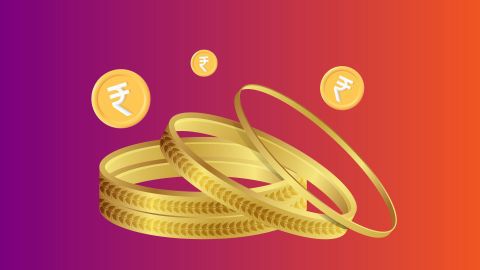2 mins
19 November 2024
Gold panning is an ancient and popular method for extracting gold from river sediments. This simple yet exciting activity involves washing sediments in search of gold particles, making it a fascinating pursuit for enthusiasts and prospectors. The gold found can later be transformed into valuable investments or even used as collateral for gold loans. This guide explores gold panning, its process, locations, safety tips, and how your discoveries can translate into financial benefits.
How does gold come into rivers?
Gold enters rivers through natural geological processes over millions of years. It originates in gold-rich rocks formed deep within the Earth’s crust. Weathering, erosion, and the natural movement of water break down these rocks, releasing gold particles into nearby rivers and streams. Heavy gold particles settle in riverbeds, creating deposits often concentrated in bends or areas with slower currents. These deposits, known as alluvial gold, are prime targets for gold panning. In India, regions with volcanic and metamorphic rocks are more likely to have gold-bearing rivers. This process makes rivers an accessible source for small-scale gold extraction.
What is the process of gold panning?
Gold panning involves a systematic process that uses simple tools and techniques to extract gold from river sediments.- Collect sediment from a riverbed or stream in a pan.
- Submerge the pan in water, gently swirling it to wash away lighter materials.
- Allow heavier particles, like gold, to settle at the bottom of the pan.
- Gradually separate the gold particles from remaining sand or debris.
Best locations for gold panning in India
India has several gold-bearing regions ideal for gold panning adventures. Karnataka, known for its Kolar and Hutti mines, is a popular choice for panning in nearby rivers. Jharkhand’s Subarnarekha River, meaning "streak of gold," is another famous location. Kerala’s Ponnani River and parts of Andhra Pradesh also offer gold panning opportunities. These regions, rich in alluvial deposits, attract prospectors and enthusiasts seeking adventure and gold. With proper research and permits, panning in these areas can yield rewarding results, blending exploration and the thrill of discovery.Safety tips for gold panning adventures
Safety is essential when embarking on gold panning adventures. Always prioritise proper preparation and caution to ensure a successful and secure experience. Dress appropriately, including sturdy footwear, to navigate slippery or rocky terrain. Use sunscreen and stay hydrated during long hours outdoors. Avoid panning in areas with strong currents or deep waters. Inform someone about your location and plans before venturing out. Carry essential tools, a first-aid kit, and snacks to stay prepared for any situation. Ensure you follow local regulations and respect the environment by avoiding harmful practices. Adhering to these tips ensures a safe and enjoyable adventure.From gold panning to gold loans: How your gold can work for you?
Gold panning adventures often result in valuable gold discoveries, which can be transformed into financial opportunities. Natural gold extracted through panning can be sold or melted into forms suitable for jewellery or investment. Additionally, Bajaj Finance offers gold loan options, allowing you to use your gold as collateral to secure funds for personal or business needs. This enables you to unlock your gold’s potential without selling it. With competitive interest rates and flexible terms, gold loans provide a practical way to turn your findings into financial benefits. This approach ensures that your gold continues to work for you.Frequently asked questions
What’s the best time of year to pan for gold?
The best time to pan for gold is during summer or post-monsoon seasons. In summer, low water levels in rivers make accessing gold-rich sediments easier. Post-monsoon, new deposits of gold particles may appear due to increased water flow and erosion. Avoid panning during heavy rains or floods for safety and better visibility. These periods offer ideal conditions for gold panning adventures.
Which is the best place to learn gold panning skills?
The best place to learn gold panning skills is in regions with active gold deposits, such as Karnataka or Jharkhand in India. Local communities or workshops near rivers like Subarnarekha offer hands-on guidance. Additionally, educational tours and mining museums often provide training for beginners. Practising at these locations ensures you gain practical experience under safe and gold-rich conditions.
What is the method of panning for gold?
Gold panning involves scooping river sediment into a shallow pan and submerging it in water. By gently swirling the pan, lighter materials like sand are washed away, leaving heavier particles behind. The process relies on gold's higher density, causing it to settle at the bottom. Repeated washing and swirling help separate gold particles from debris, revealing valuable finds in the pan.
How to identify gold in a pan?
To identify gold in a pan, look for bright, yellowish particles that don’t tarnish or change colour in water. Gold is heavier than most sediments, so it settles at the bottom of the pan. Unlike mica or other minerals, gold retains its shine even when wet. Scrape gently to test malleability—gold is soft and won’t crumble, ensuring accurate identification.
Show More
Show Less
Bajaj Finserv App for All Your Financial Needs and Goals
Trusted by 50 million+ customers in India, Bajaj Finserv App is a one-stop solution for all your financial needs and goals.
You can use the Bajaj Finserv App to:
Apply for loans online, such as Instant Personal Loan, Home Loan, Business Loan, Gold Loan, and more.
You can use the Bajaj Finserv App to:
Apply for loans online, such as Instant Personal Loan, Home Loan, Business Loan, Gold Loan, and more.
- Explore and apply for co-branded credit cards online.
- Invest in fixed deposits and mutual funds on the app.
- Choose from multiple insurance for your health, motor and even pocket insurance, from various insurance providers.
- Pay and manage your bills and recharges using the BBPS platform. Use Bajaj Pay and Bajaj Wallet for quick and simple money transfers and transactions.
- Apply for Insta EMI Card and get a pre-approved limit on the app. Explore over 1 million products on the app that can be purchased from a partner store on Easy EMIs.
- Shop from over 100+ brand partners that offer a diverse range of products and services.
- Use specialised tools like EMI calculators, SIP Calculators
- Check your credit score, download loan statements, and even get quick customer support—all on the app.






